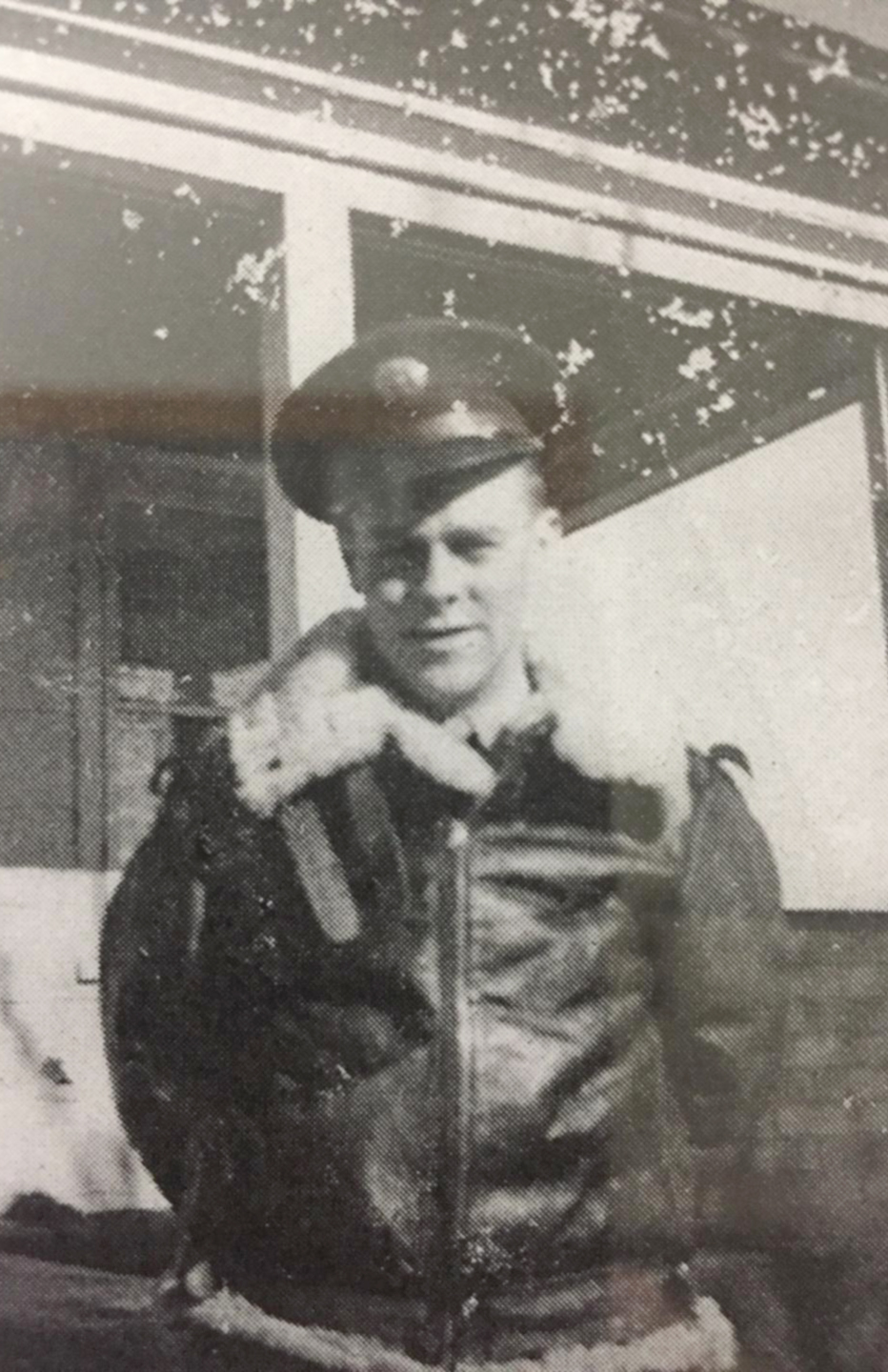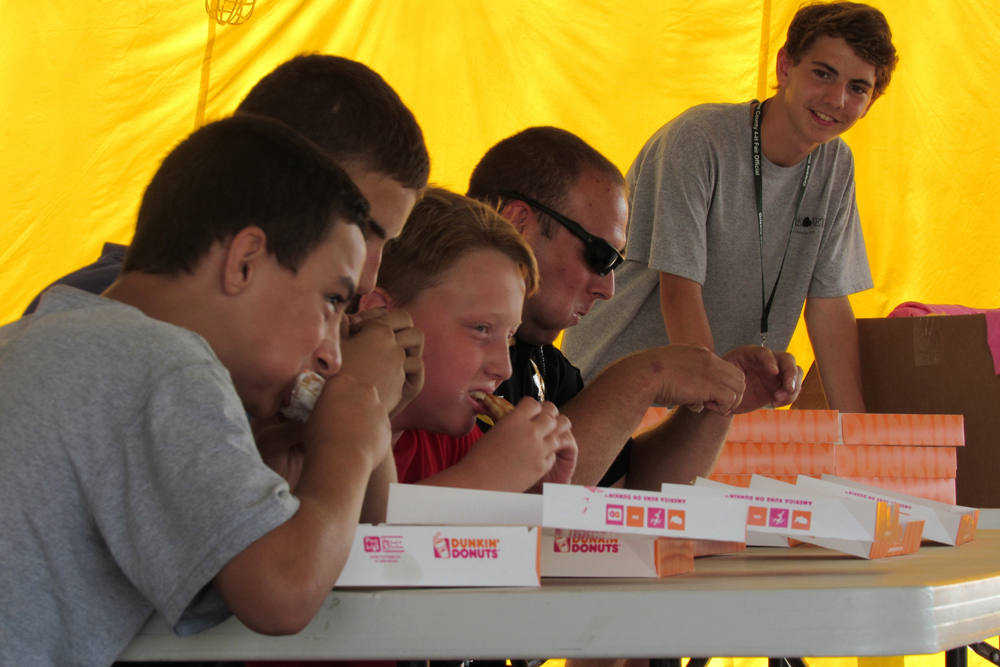Hank St. George – Parma Center World War II hero

by David Crumb
Parma Hilton Historian
On November 26, 1944, Hank St. George of Parma Center Road, Hilton, was on a B-17 Flying Fortress flying over Germany with a crew of nine men. Hank was the tail gunner. Quilla Reed, a slim 21-year-old, bulky in his flying suit, grabs a portable oxygen bottle, leaves his post at the top turret, and lurches aft along the catwalk above the bomb bay. He deactivates the bombs. Then he gropes for a handle to crank open the bay – the electric motor is out – and releases three tons of dud bombs somewhere over the Netherlands.
“How much time?” asks the pilot, Lt. John Stevens. “Johnny, there’s no time,” Reed replies. “Everything’s on fire – get out!”
“We’ve lost Hank,” he thinks, imagining the gunner trapped in the plummeting tail. Seattle Sleeper explodes! Half-a-century later, Quilla Reed returns to Bassingbourn for the first time since the morning of November 26, 1944, to finish the story of Seattle Sleeper.
Lt. Stevens jumped out seconds before the explosion. When the tail broke off, our Hilton boy, Hank (son of Ada St. George of Parma Center), was left hanging from his seat belt. He crawled into what remained of the plane and found the wounded waist gunner lying in a puddle of icy blood. Hank gave him a shot of morphine and said, “Now, when you get far enough out, you just pull the ripcord.” He then rolled him out the hole in the fuselage and followed, along with the radio man. Every chute opened, and every man survived.
Hank’s taped interview years later went like this:
“We were flying over Holland at 28,000 feet when little black specks came out of the clouds: German fighters. They came four abreast and climbed between two formations of bombers. After the fourth attack, the #3 engine of the ‘Seattle Sleeper’ started to burn, followed by the cry from the cockpit, ‘Abandon Ship, Abandon Ship!’ A fighter approached the tail, and a 20mm shell cut my pants and whipped this gun out of my hands. I switched my oxygen mask to a portable tank and went to the waist for easier exit. Waist-gunner Trombley was hit in his leg and lay on the floor. I looked out of the window and saw the #3 engine still burning. I hoped that Pratt could come out of his Top-Turret. I put my chute on and helped Trombley to put on his after having given him a shot of morphine. He asked the radio-operator Pratt, ‘Where are we?’ and Pratt said, ‘We’re over Holland.’
“We stood by the side door of the B-17, but nobody jumped. I said, ‘I don’t know about you guys, but I go. See you on the ground.’ I jumped first, and after I had pulled the ripcord and had broken through the cloud cover, I saw other chutes above me. I was swinging back and forth under my chute like a pendulum under a clock. Before jumping, I had forgotten to zip up my flying suit, so all my papers, money, and my escape kit blew out. I had my flying shoes on. It was recommended to take an extra pair of extra sturdy GI walking shoes into the plane before the mission and attach them to the harness before bail-out. I hadn’t.”
Fortunately, the men landed in Holland and not Germany. Members of the Dutch Underground befriended them. Hank started to walk with the intention to ultimately reach the allied lines around 80 miles south from where he had landed. His first stop was at a small home with no telephone lines connected to it. He knocked, and a young woman with a baby let him in. She spoke no English and Hank no Dutch. She gave him some bread and warm milk. Later a man who spoke English entered the scene. The man gave Hank his overcoat and told him to follow him on his bike to his home, where he hid St. George in a potato pit. Around midnight, the man gave Hank a map and told him the route to take. His next stop was Veenhuizen civilian prison. Word had traveled through the Dutch Underground about the crash and that the crew had parachuted. The uniformed guard, a Mr. Reyss, was alert that Hank must be one of them not captured by the Germans. He put Hank in civilian clothes and put him to work in the prison kitchen. Later he was sent to Apeldoorn, about 60 miles from Haulerwijk, the site of the crash.
The Woltman family who lived on the Jachtlaan not far from the royal palace “Het Loo,” the residence of Queen Wilhelmina, were his hosts. In Mid-December, Hank was still with the Woltmans. Food was scarce, the weather was extremely cold, and the Germans were close by.
Hank had loaned his thick flying gloves to the Woltman daughter, Tinnie, and German officials had confiscated them, noting the inside label, property of the US Army Air Forces. That night, Hank had to spend the night in a tree outside for fear that the Germans had seen the girl return the house. Hank was sent to another safe house the following morning.
Hank endured many more harrowing experiences during his stay in Holland. Through the care and guidance of the friendly Dutch citizens, he was finally rescued in Utrecht after five months on the run. On May 5, 1945, Canadian troops entered Utrecht. From Utrecht, he went to Eindhoven and then Namur in Belgium, then to Bruxelles. Hank then traveled to Camp Lucky Strike near Le Havre in France, where American troops awaited transportation back to the United States. In Camp Lucky Strike, Hank met Rene Pratt again, the radio-operator aboard “Seattle Sleeper.” In LeHavre, St. George boarded an Italian ship and came home via New York City, 15 pounds lighter than when he left home. His arrival back in Parma Center was a cause of much excitement.
Hank’s nephew, Fred Ryan of Clarendon, was the source of additional information. St. George told him about other experiences, such as hiding under the floorboards in a crawl space in one Dutch home. Nazi soldiers came to inspect and search for prisoners, and just before departing, they fired a number of shots at the floorboards, which penetrated the crawl space. Prudently, Hank had crawled in the section under the tile coal stove above and was not hit.
Parma resident, Tom Coyle, remembers the day St. George returned to his anxious family in Parma Center. Coyle told the following story the day Hank returned from the service. “I was about seven years old and was standing in front of my house on Parma Center Road. Hank was walking up the road towards me; I did not recognize him. He stopped and said hello and told me who he was and then I remembered him. He had been away a year. His family was very excited and relieved to have him home. They lived next door. I remember him as a very jovial and fun guy.” Coyle added, “A few years later, on a return visit, Hank drove his mother, sister Pat, and me on a trip to New York City. It was my first trip away from home. In New York, Hank and his wife took us all around town to see the sights.”
Norman “Toppy” Feil, a good buddy of St. George, now age 95 and living in Florida, said, “Hank and I were best friends. We did a lot together in our early days and had a lot of fun. When Hank came home from the war, he told me harrowing stories of his close calls with the German soldiers. Once hiding in the closet of a Dutch home, Nazis came in and killed everyone there, but Hank managed to escape by hiding behind heavy garments in the back of the closet.”
Note: The information for this story comes from the 2009 book, Not Home For Christmas; A Day in the Life of the Mighty Eighth, by John Meurs and National Geographic, March 1994, pages 90-112.
The original initiative for doing the story came from conversations with Henry St. George’s nephew, Fred Ryan. Hank was born on November 12, 1923. He married Dorothy DiMaria in 1946. After concluding service to his country, Hank went to work for Pan American Airlines as a flight engineer in New York City. He and Dorothy and their three children lived on Long Island. Hank died on December 11, 2001, at the age of 78. He was a graduate of Hilton High School class of 1941. The class poem in the 1941 yearbook ascribed to him was, “A flying career is ahead for this boy. For flying is his greatest joy.” A truer class prophecy was never envisioned.


